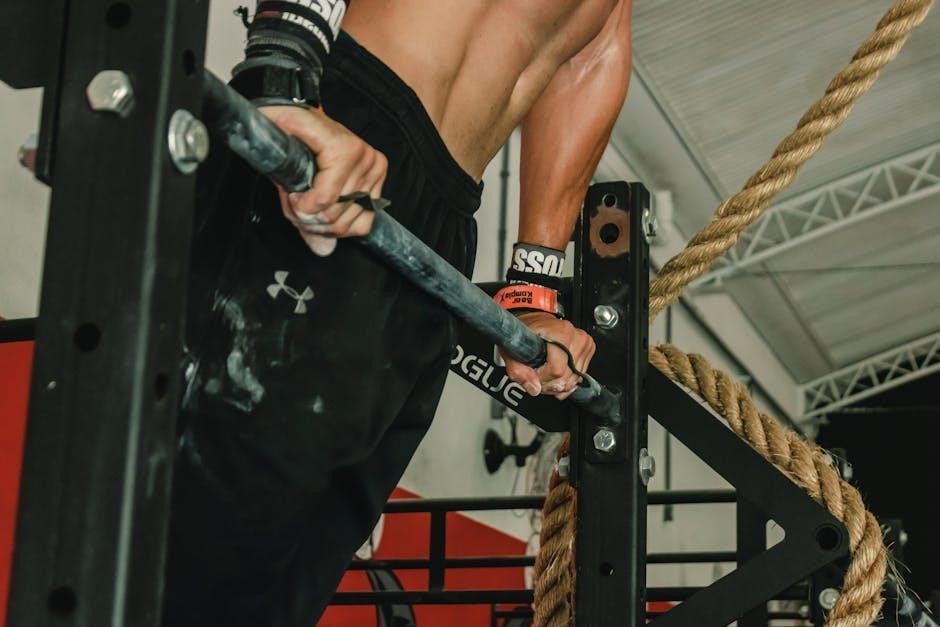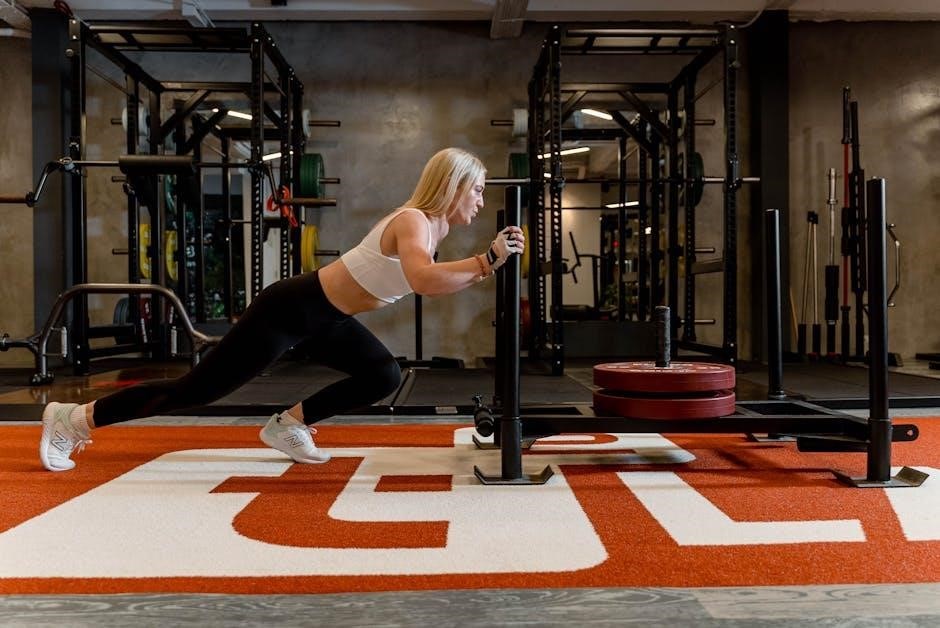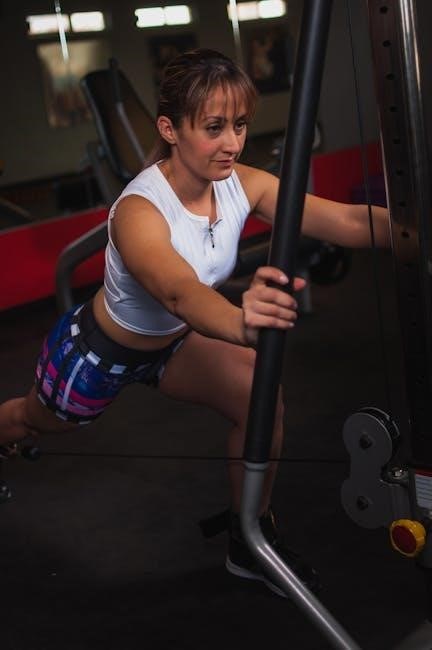A structured 12-week fitness plan dividing workouts into push, pull, and legs days, targeting muscle growth and strength. Ideal for intermediates seeking balanced development and progressive overload.

Overview of the Push Pull Legs (PPL) Workout Split

The Push Pull Legs (PPL) workout split divides training into three focused days: push, pull, and legs. Push day targets chest, shoulders, and triceps, while pull day emphasizes back, biceps, and rear delts. Legs day covers quads, hamstrings, glutes, and calves. This 6-day program includes one rest day, allowing for balanced development and recovery. Each workout is structured to maximize muscle growth and strength, with exercises tailored to intermediate lifters. The PPL split is popular for its simplicity and effectiveness, ensuring all major muscle groups are trained progressively over the 12-week cycle.
Benefits of a 12-Week Training Cycle
A 12-week training cycle offers a balanced approach to muscle growth and strength gains. It allows for progressive overload, ensuring consistent improvement without overtraining. This duration enables adaptation across all muscle groups, enhancing overall physique. The structured timeline helps maintain motivation and track progress effectively, making it ideal for intermediate lifters seeking sustainable results.
Who is the Program Designed For?
This program is tailored for intermediate lifters with foundational knowledge of weights and basic exercise form. It suits those seeking balanced muscle development and strength gains. Individuals with at least one year of consistent training experience will benefit most, as the routine assumes familiarity with essential movements and progressive overload techniques. It’s also ideal for those who prefer a structured, goal-oriented approach to their fitness journey, aiming to enhance muscle mass and overall athleticism effectively.

Push Day Workout Plan
Push day targets chest, shoulders, and triceps, focusing on exercises like bench presses, shoulder presses, and dips. It’s part of a 6-day Split, ideal for intermediates.
Push Day Exercises: Chest, Shoulders, and Triceps
Push day focuses on exercises targeting the chest, shoulders, and triceps. Key movements include the barbell bench press, incline dumbbell press, and overhead shoulder press. Accessories like dips and tricep pushdowns enhance muscle development. Emphasizing compound lifts ensures overall growth and strength. Progression involves increasing weights or reps weekly to challenge muscles effectively. Proper form is crucial to avoid injury and maximize results. This balanced approach ensures comprehensive development of the pushing muscles, supporting both aesthetic and functional goals over the 12-week cycle.
Sample Push Day Routine with Sets and Reps
A typical push day routine includes exercises targeting the chest, shoulders, and triceps. Begin with the barbell bench press for 3 sets of 8-10 reps, followed by incline dumbbell presses for 3 sets of 8-10 reps. Include shoulder presses for 3 sets of 8-10 reps and dips for 3 sets of 10-12 reps. Add tricep pushdowns for 3 sets of 12-15 reps to isolate the triceps. Optional core work like hanging leg raises can be added for 3 sets of 10-12 reps. Ensure a proper warm-up and maintain strict form throughout to maximize gains and prevent injury.
Progression Strategies for Push Day
To ensure continuous progress, increase weights by 2.5-5lbs weekly or add an extra set/reps to exercises. Incorporate advanced techniques like drop sets or rest-pause reps for triceps and shoulders. Periodically swap barbell exercises with dumbbells to target muscles differently. Focus on increasing volume by adding auxiliary movements like cable flyes or lateral raises. Use a deload week every 4-6 weeks to recover and prevent overtraining. Track lifts to ensure consistent improvement, adjusting reps or weights as strength levels rise. Maintain strict form to maximize gains and minimize injury risks throughout the 12-week cycle.
Pull Day Workout Plan

Focuses on back, biceps, and rear delts with exercises like pull-ups, rows, and curls. Structured over 6 days weekly for 12 weeks to build muscle and strength.
Pull Day Exercises: Back, Biceps, and Rear Delts
Pull day focuses on building a strong back, biceps, and rear delts. Key exercises include pull-ups, barbell rows, and lat pulldowns for the back, targeting lats and rhomboids. For biceps, dumbbell curls and hammer curls are essential, while face pulls and reverse flyes work the rear delts. These exercises promote balanced development and improve overall upper body strength. Adjust weights and reps according to fitness levels to ensure progressive overload and muscle growth throughout the 12-week cycle.
Sample Pull Day Routine with Sets and Reps
A typical pull day routine includes exercises like pull-ups (4 sets of 8-12 reps), barbell rows (4 sets of 8-10 reps), and lat pulldowns (3 sets of 10-12 reps) for the back. For biceps, dumbbell curls (3 sets of 10-15 reps) and hammer curls (3 sets of 12-15 reps) are effective. Rear delts are targeted with face pulls (3 sets of 12-15 reps) and reverse flyes (3 sets of 15-20 reps). This routine balances strength and hypertrophy, ensuring progressive overload and muscle growth over the 12-week cycle.
Progression Strategies for Pull Day
Enhance pull day effectiveness by gradually increasing weights or reps weekly. Start with 8-10 reps for compound exercises like rows and pull-ups, progressing to 10-12 reps. Incorporate variations such as weighted pull-ups or close-grip rows to target different muscle fibers. For biceps, increase curl weights or switch to concentration curls for deeper engagement. Rear delts benefit from higher rep ranges (12-15) with progressive overload. Adjust rest periods and intensity techniques like drop sets or supersets to maximize growth. Periodically deload to allow recovery, ensuring sustained progress throughout the 12-week cycle. Consistent progression drives strength and hypertrophy gains.

Legs Day Workout Plan
A comprehensive plan targeting quads, hamstrings, glutes, and calves through compound lifts like squats and deadlifts, ensuring balanced lower body development and progressive overload.
Legs Day Exercises: Quads, Hamstrings, Glutes, and Calves
Legs day focuses on building strength and size in the lower body. Key exercises include squats and deadlifts for compound lifts, targeting quads, hamstrings, and glutes; Leg press and lunges isolate quads and hamstrings, while glute bridges and hip thrusts emphasize glute development. Calf raises, both seated and standing, target calf muscles for overall leg symmetry. These exercises ensure balanced development and functional strength, with variations to suit intermediate lifters. Accessory work like leg curls and calf presses further enhance muscle growth and prevent imbalances. Proper form and progressive overload are emphasized to maximize results over the 12-week cycle.
Sample Legs Day Routine with Sets and Reps
A typical legs day starts with compound lifts like barbell squats (4 sets of 8-10 reps) and Romanian deadlifts (4 sets of 8-12 reps) to target quads, hamstrings, and glutes. Isolation exercises include leg press (3 sets of 10-12 reps) for quad development and lunges (3 sets of 10-15 reps per leg) for overall leg symmetry; Glute bridges (4 sets of 12-15 reps) and standing calf raises (5 sets of 15-20 reps) focus on glutes and calves. Accessory work like leg curls (3 sets of 10-12 reps) and calf presses (3 sets of 15-20 reps) round out the routine. Warm up with dynamic stretches and start with lighter weights to ensure proper form and safety. This balanced approach ensures comprehensive lower body development.
Progression Strategies for Legs Day
Progression on legs day involves gradually increasing intensity over the 12-week cycle. Start with a weight that allows proper form, then aim to add 2.5-5% weekly. Focus on increasing reps before adding weight, ensuring each set challenges the target muscles. For example, if doing squats with 70kg for 8 reps, aim for 9-10 reps in the following weeks before increasing to 72.5kg. Incorporate intensity techniques like rest-pause sets or cluster sets in weeks 7-12 to break plateaus. Track progress by logging weights and reps, ensuring consistent improvement. Adjust rest periods and volume as needed to maintain muscle engagement and avoid overtraining.
Program Overview
A 12-week structured training plan focusing on push, pull, and legs days. Designed for intermediate lifters, it promotes balanced muscle growth and strength through periodized workouts and consistent progression.
12-Week Program Duration and Structure
The 12-week Push Pull Legs program is divided into three phases, each lasting four weeks. Phase 1 focuses on building a foundation with moderate intensity. Phase 2 increases the challenge with higher volume and weight. Phase 3 emphasizes strength and muscle endurance. Workouts are spread over six days, allowing optimal recovery. Each week includes two push days, two pull days, and two legs days, ensuring balanced development. The structure progresses gradually, preventing plateaus and promoting continuous improvement throughout the cycle.
Target Audience: Intermediate Lifters
This program is specifically designed for intermediate lifters who have already built a foundation of strength and technique. It assumes familiarity with basic exercises and progressive overload principles. The 12-week structure is tailored to help intermediates break through plateaus, enhance muscle balance, and improve overall athleticism. With its focused push, pull, and legs split, the program avoids overtraining while ensuring consistent progress. It is not suited for complete beginners, as it requires prior experience with compound movements and structured training. Advanced lifters may also benefit but could need additional intensity or volume. The program strikes a balance, making it ideal for intermediates aiming to build muscle and strength effectively.
Training Frequency: 6 Days Per Week
The program requires 6 training days per week, divided into push, pull, and legs days, with one rest day. This frequency ensures consistent muscle stimulation and recovery. Each workout targets specific muscle groups, allowing for optimal recovery time. The 6-day split is designed to maximize progress without overtraining, making it suitable for intermediates. Rest days are crucial for muscle repair and growth, ensuring the body adapts to the demands of the program. Consistency is key, and adhering to this schedule will yield the best results over the 12-week period. Proper planning and dedication are essential to maintain this training frequency effectively.
Exercise Selection and Periodization
The program employs a strategic mix of compound and isolation exercises, prioritizing movements like bench presses, rows, and squats for maximum muscle engagement. Periodization is implemented by varying intensity, volume, and rep ranges across the 12 weeks. Early phases focus on hypertrophy with higher reps, while later stages emphasize strength and power with lower reps. This structured approach ensures progressive overload and avoids plateaus. Exercise selection is tailored to target all major muscle groups, with adjustments based on individual goals and recovery. Proper periodization balances intensity and recovery, optimizing muscle growth and strength gains throughout the program. Consistency is key to success.

Nutrition and Recovery
Adequate nutrition is crucial, focusing on a caloric surplus with sufficient protein to support muscle growth. Rest and recovery, including sleep and hydration, are emphasized to optimize performance and prevent injury.
Proper recovery practices, such as active rest and stress management, complement the training routine, ensuring the body adapts effectively throughout the 12-week cycle.
Dietary Recommendations for Muscle Growth
A caloric surplus is essential for muscle growth, with protein intake at 1.2-2.2g per kg of body weight. Carbohydrates and fats should be balanced to fuel workouts and support hormone production. Prioritize whole foods like lean meats, fish, eggs, and whole grains. Include fiber-rich vegetables for digestion and overall health. Aim for 5-6 meals daily to maintain a positive nitrogen balance. Stay hydrated with water and consider supplements like creatine or BCAAs to enhance performance. Consistency in nutrition is key to maximizing gains throughout the 12-week program.

Importance of Rest and Recovery
Adequate rest and recovery are crucial for muscle repair and growth. Each muscle group needs 48-72 hours between sessions. Ensure 7-9 hours of quality sleep nightly to support hormonal balance and recovery. Incorporate rest days or light activities like stretching or cardio. Active recovery, such as foam rolling or walking, can enhance blood flow without straining muscles. Overtraining can lead to fatigue and injury, hindering progress. Prioritize recovery techniques like massage, ice baths, or compression to maintain performance and prevent setbacks during the 12-week program.

Tracking Progress
Monitor strength gains, body composition changes, and workout consistency. Track weights, reps, and body fat percentage weekly to ensure progress toward muscle growth and strength goals;
How to Monitor Strength Gains
Track strength improvements by logging weights and reps for each exercise weekly. Compare progress over the 12 weeks, aiming to increase load or volume gradually. Use a workout journal to document each session, ensuring consistency and accountability. Celebrate small victories and adjust training as needed to maintain momentum. Regularly test one-rep maxes for key lifts to measure overall strength development. This systematic approach helps identify plateaus and optimizes the training cycle for continuous gains in muscle and power. Stay consistent and patient, as significant strength improvements take time and dedication to the program.
Tracking Body Composition Changes

Monitor body composition by taking weekly progress photos, measurements, and weighing yourself. Use a body fat caliper for precise tracking. Track visible changes in muscle definition and overall physique. Adjust your diet and training based on progress, ensuring you’re in a calorie surplus for muscle growth. Regularly assess how your clothes fit and note increases in muscle mass. Use progress photos to visually track changes over the 12-week cycle. Consistency in tracking helps maintain accountability and guides adjustments for optimal results. This data-driven approach ensures you stay on course to achieve your muscle-building and fat-loss goals effectively.
The 12-week Push Pull Legs program offers a balanced, effective approach to building strength and muscle. Consistency and dedication will yield transformative results. Start your journey today!
Final Thoughts on the 12-Week PPL Program
The 12-week Push Pull Legs program is a well-structured, effective plan for intermediate lifters seeking balanced muscle growth and strength. By focusing on push, pull, and legs days, it ensures comprehensive development. The program’s progressive overload strategy and clear exercise selection make it ideal for those committed to consistent training. With proper nutrition and recovery, participants can achieve significant gains in muscle mass and overall fitness. This program is a great choice for anyone looking to enhance their physique and strength in a structured, 12-week timeframe. Stay dedicated, and the results will speak for themselves.
Downloadable PDF Resources
Access a customizable 12-week Push Pull Legs PDF template, complete with workout schedules and progression tracking. Ideal for organizing your fitness journey effectively and efficiently.
Sample 12-Week Push Pull Legs PDF Template
The PDF template provides a detailed 12-week workout plan, divided into push, pull, and legs days. Each week includes specific exercises, sets, and reps, allowing for progressive overload. The template is customizable, enabling users to track their strength gains and adjust routines as needed. It also includes sections for nutritional advice and recovery tips, ensuring a holistic approach to muscle growth. Perfect for intermediates, the template offers a clear structure to follow, helping users stay organized and motivated throughout their fitness journey.
